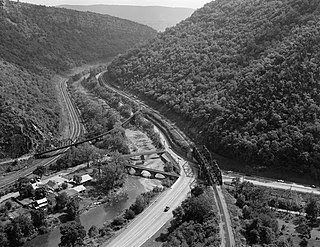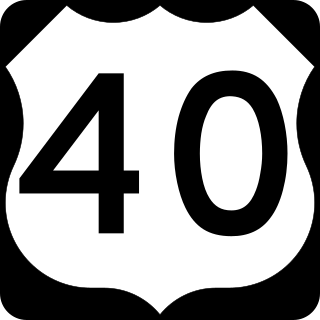Related Research Articles

Allegany County is a county located in the northwestern part of the U.S. state of Maryland. As of the 2020 census, the population was 68,106. Its county seat is Cumberland. The name Allegany may come from a local Lenape word, welhik hane or oolikhanna, which means 'best flowing river of the hills' or 'beautiful stream'. A number of counties and a river in the Appalachian region of the U.S. are named Allegany, Allegheny, or Alleghany. Allegany County is part of the Western Maryland region of the state, and is part of the Cumberland metropolitan area.

Cumberland is a city in and the county seat of Allegany County, Maryland, United States. At the 2020 census, the city had a population of 19,075. Located on the Potomac River, Cumberland is a regional business and commercial center for Western Maryland and the Potomac Highlands of West Virginia. It is the primary city of the Cumberland metropolitan area, which had 95,044 residents in 2020.

Frostburg is a city in Allegany County, Maryland. It is located at the head of the Georges Creek Valley, 8 miles (13 km) west of Cumberland. The town is one of the first cities on the "National Road", US 40, and the western terminus of the Western Maryland Scenic Railroad. It is part of the Cumberland metropolitan area.

An adit or stulm is a horizontal or nearly horizontal passage to an underground mine. Miners can use adits for access, drainage, ventilation, and extracting minerals at the lowest convenient level. Adits are also used to explore for mineral veins. Although most strongly associated with mining, the term adit is sometimes also used in the context of underground excavation for non-mining purposes; for example, to refer to smaller underground passageways excavated for underground metro systems, to provide pedestrian access to stations, and for access required during construction.

Maryland Route 36 is a 29.43-mile (47.36 km) state highway located in Allegany County, Maryland, United States. MD 36's southern terminus is at the West Virginia Route 46 (WV 46) bridge in Westernport and its northern terminus at U.S. Route 40 Alternate near Cumberland. Between Westernport and Frostburg, it is known as Georges Creek Road, and from Frostburg to Cumberland it is known as Mount Savage Road. Like the majority of Maryland state highways, MD 36 is maintained by the Maryland State Highway Administration (MDSHA).

The Cumberland and Pennsylvania Railroad (C&P) was an American railroad which operated in Western Maryland. Primarily a coal hauler, it was owned by the Consolidation Coal Company, and was purchased by the Western Maryland Railway (WM) in 1944.

Mount Savage is an unincorporated community and census-designated place (CDP) in Allegany County, Maryland, United States. As of the 2010 census it had a population of 873.
Eckhart Mines is an unincorporated community and census-designated place (CDP) in Allegany County, Maryland, United States. As of the 2010 census it had a population of 932.

The Eckhart Branch Railroad was a railroad that operated in the Cumberland, Maryland area in the 19th century.

Turtle Creek is a 21.1-mile-long (34.0 km) tributary of the Monongahela River that is located in Allegheny and Westmoreland counties in the U.S. state of Pennsylvania. Situated at its juncture with the Monongahela is Braddock, Pennsylvania, where the Battle of the Monongahela was fought in 1755.
Clarysville is an unincorporated community and census-designated place (CDP) in Allegany County, Maryland, United States. As of the 2010 census it had a population of 73.

The Leadville mining district, located in the Colorado Mineral Belt, was the most productive silver-mining district in the state of Colorado and hosts one of the largest lead-zinc-silver deposits in the world. Oro City, an early Colorado gold placer mining town located about a mile east of Leadville in California Gulch, was the location to one of the richest placer gold strikes in Colorado, with estimated gold production of 120,000–150,000 ozt, worth $2.5 to $3 million at the then-price of $20.67 per troy ounce.

U.S. Route 40 Alternate is the U.S. Highway designation for a former segment of U.S. Route 40 (US 40) through Garrett and Allegany counties in Maryland. The highway begins at US 40 near exit 14 on Interstate 68 (I-68) and runs 31.80 miles (51.18 km) eastward to Cumberland, where it ends at exit 44 on I-68. Alt US 40 is maintained by the Maryland State Highway Administration (MDSHA).

The Argo Tunnel is a 4.16-mile (6.69 km) mine drainage and access tunnel with its portal at Idaho Springs, Colorado, USA. It was originally called the Newhouse Tunnel after its primary investor, Salt Lake City mining magnate Samuel Newhouse, and appears by that name in many industry publications from the time period when it was constructed. The tunnel intersected nearly all the major gold mines between Idaho Springs and Central City, and is the longest such drainage tunnel in the Central City-Idaho Springs mining district.

Savage Mountain is an anticline extending from Bedford County, Pennsylvania southwest into Western Maryland. It is the western side of the Ridge-and-Valley Appalachians, and the eastern portion of the ridge forms the border of Garrett and Allegany Counties of Maryland.

The Jeddo Tunnel is a drainage tunnel at water level in Pennsylvania. It is one of the Coal Region's biggest discharges of mine water. The tunnel is five miles long and was constructed between 1891 and 1894, and at the time of its construction, was reputed to be the largest mine drainage tunnel in the world. It consists of major tunnels A and B, and minor tunnels C, D and X.
The Audenried Tunnel, also known as the Audenried Mine Tunnel, is a drainage tunnel located in East Union Township, Schuylkill County, Pennsylvania, in the United States. It is approximately three miles long and drains the western portion of a coal basin near Kelayres.
The Oneida Number One Tunnel is a mine drainage tunnel in Schuylkill County, Pennsylvania, in the United States. It is one of five major mine tunnels in the watershed of Catawissa Creek. The tunnel discharges into Sugarloaf Creek near Lake Choctaw and Lake Susquehanna. The water quality of the tunnel's discharge has improved significantly since the installation of a treatment system at the site of the tunnel in 2001.
The Quakake Tunnel is a mine drainage tunnel in Carbon County, Pennsylvania, in the United States. The tunnel is several thousand feet long and has a discharge of thousands of gallons per minute. It was the subject of an Operation Scarlift report. The tunnel is a major contributor of acid mine drainage to the watershed of the Lehigh River.
Little Black Creek is a tributary of Black Creek in Luzerne County, Pennsylvania, in the United States. It is approximately 2.2 miles (3.5 km) long and flows through Lattimer, Harleigh, and Hazle Township. The watershed of the creek is largely on coal mining land. It only has an intermittent flow and some of its waters drain into the Jeddo Tunnel instead of Black Creek. The creek is in the Eastern Middle Anthracite Field. There is at least one bridge crossing the creek.
References
- Stegmaier, Jr., Harry; Dean, David; Kershaw, Gordon; Wiseman, John; Allegany County - A History, Parsons, WV: McClain Printing Co. 1976, pp 227.
- Harvey, Katherine A. The Best-Dressed Miners - Life and Labor in the Maryland Coal Region 1835-1910, 1969, Cornell University Press.
- Cordts, Jeanne M. "The Hoffman Drainage Tunnel: A Remarkable Underground Achievement," J. Alleghenies, Vol. XIII, 1977.
- Van Newkirk, Betty, Tunnel Visions," J. Alleghenies, Vol. XXXI – 1995, pp. 69.
- Frostburg Mining Journal, various, 1903-1906. Particularly, July 28, 1906.
- J. Alleghenies Vol XII, 1977, Council of the Alleghenies, Frostburg, MD.
- "The Earliest Railroad Activities in Western Maryland, 1828-1870," 1996, J. Alleghenies, Vol. XXXII, ISSN 0276-7449.